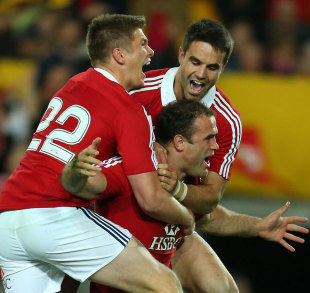|
Ask John
Lions prove size matters
John Griffiths
August 1, 2013

The Haka - but what do the words mean? © Getty Images
Enlarge
Welcome to the latest edition of Ask John where renowned rugby historian John Griffiths will answer any rugby-related query you have! So, if there's something you've always wanted to know about the game we love but didn't know who to ask, or you think you can stump our expert - then get involved by sending us a question. In this edition, John answers questions on Jim Telfer's 1967 Scotland squad for South Africa, the changing shape of players, the Haka and law changes. I believe Jim Telfer led a Scottish tour of South Africa in 1967, but I cannot find a record for it in Statsguru. Mark Wilson, Scotland The tour was not an international tour but one undertaken by the Scottish Borders. A group of 22 players led by Melrose's Jim Telfer under co-managers James Grieve and Andrew Bowie flew out from Turnhouse Airport on May 6 1967 for a two-week, four-match tour of the Republic.
The playing squad was as follows:
Fourteen of the 22 were (or became) Scotland internationalists. The tourists' results were as follows:
The most exciting match was against Transvaal, which drew a crowd of 25,000. The home side escaped with a draw when their Springbok full-back, Mickey Gerber, landed a last-minute penalty goal. What is the translation of the Ka Mate haka? David Clark, England Arguably the free translation provided by Dave Gallaher and Billy Stead, the captain and vice-captain of the original All Blacks of 1905, in their rugby classic The Complete Rugby Footballer on the New Zealand System which was published in 1906 is as good as any. It was as follows:
Together we live, together we die,
How much bigger are today's players than those of fifty or so years ago? John Gray, Scotland The sharpest rugby mind of the 20th century belonged to Dr Danie Craven. He was capped for South Africa mainly as a scrum-half but was good enough to play Tests as a centre, fly-half and once even as a No.8. He skippered the Springboks against the 1938 Lions, became a distinguished Springbok coach and manager and later served the South African Rugby Board as its President. In December 1952, after making a detailed study of hundreds of Test players, he published an interesting table of average (mean) heights and weights by position. The table below compares Craven's results (column two) with the corresponding stats for members of the victorious third Test Lions team in Australia.
The results for the weights are:
When did rugby actually go metric - if it ever did in IRB rules, changing the 25-yard line to the 22 meters line and so on? CH, France As far back as 1969 the Rugby Football Union set up a sub-committee to recommend adaptation of the game's Laws to the metric system.

Jamie Roberts weighs 44.6% more than a centre 50 years ago
© Getty Images
Enlarge
The metrication proposals were subsequently approved the year later but it was not until the 1976 annual meeting of the International Rugby Board (IRB) that it was decreed that the pitch markings (and other dimensions) should adopt the metric system. At the time, only the four Home Unions and the Tri-Nations were members of the IRB. Continental Unions had previously used the same laws as the IRB, but their handbooks had shown the pitch dimensions in metres. When did rugby adopt the advantage law? Peter Wilson, England Arguably rugby's best example of "advantage" is the penalty try. This was introduced to the Laws in 1888, the relevant clause stating: "If in the opinion of the Referee, on a claim from the opposite side, a try would undoubtedly have been gained but for the unfair play or interference by the defending side, he should adjudge such a try." In 1892 this was extended to provide for the defending side: "[The Referee] shall disallow a try and adjudge a touch down, if a try would undoubtedly not have been gained but for unfair play or interference by the attacking side." It was not until 1910, however, that the "advantage" Law pertaining to general play first appeared. The section of the Laws relating to Irregularities Not Provided For was rewritten to read: "If when a Law is broken or any irregularity of play occurs not otherwise provided for, and any advantage is gained there-from by the opposite side, the Referee shall not blow his whistle but shall allow the game to proceed, but if no advantage is gained by such side, and if no other procedure is provided, the ball shall be taken back to the place where the breach of the Law or irregularity occurred." In 1926, the International Board issued a circular laying down further: "Referees should see that an advantage generally meaning 'territorial advantage' is gained by the non-offending side, failing which they should whistle for the offence. An opportunity of gaining an advantage is not sufficient." © ESPN Sports Media Ltd
|
Live Sports
Communication error please reload the page.
-
Football
-
Cricket
-
Rugby
-
- Days
- Hrs
- Mins
- Secs
F1 - Abu Dhabi GP
Abu Dhabi Grand Prix December 11-131. Max Verstappen ()
2. Valtteri Bottas (Mercedes)
3. Lewis Hamilton (Mercedes)
4. Alexander Albon ()
5. Lando Norris ()
6. Carlos Sainz Jr ()
-
ESPNOtherLive >>
Boxing - Nelson v Wilson; Simmons v Dickinson; Joshua v Gavern (Metro Radio Arena, Newcastle)
Golf - Houston Open
Snooker - China Open
Tennis - Miami Open

